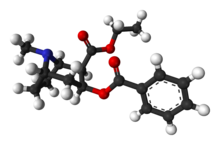 | |
 | |
| Clinical data | |
|---|---|
| Other names | benzoylecgonine ethyl ester, ethylbenzoylecgonine, |
| Pregnancy category |
|
| Routes of administration | Produced from ingestion of cocaine and ethanol |
| ATC code |
|
| Legal status | |
| Legal status |
|
| Identifiers | |
| |
| CAS Number | |
| PubChem CID | |
| ChemSpider | |
| UNII | |
| ChEMBL | |
| CompTox Dashboard (EPA) | |
| ECHA InfoCard | 100.164.816 |
| Chemical and physical data | |
| Formula | C18H23NO4 |
| Molar mass | 317.385 g·mol−1 |
| 3D model (JSmol) | |
| |
Cocaethylene (ethylbenzoylecgonine) is the ethyl ester of benzoylecgonine. It is structurally similar to cocaine, which is the methyl ester of benzoylecgonine. Cocaethylene is formed by the liver when cocaine and ethanol coexist in the blood.[1] In 1885, cocaethylene was first synthesized (according to edition 13 of the Merck Index),[2] and in 1979, cocaethylene's side effects were discovered.[3]
- ^ Laizure SC, Mandrell T, Gades NM, Parker RB (January 2003). "Cocaethylene metabolism and interaction with cocaine and ethanol: role of carboxylesterases". Drug Metabolism and Disposition. 31 (1): 16–20. doi:10.1124/dmd.31.1.16. PMID 12485948.
- ^ Jones AW (April 2019). "Forensic Drug Profile: Cocaethylene". Journal of Analytical Toxicology. 43 (3): 155–160. doi:10.1093/jat/bkz007. PMID 30796807.
- ^ * Doward J (8 November 2009). "Warning of extra heart dangers from mixing cocaine and alcohol". The Guardian.